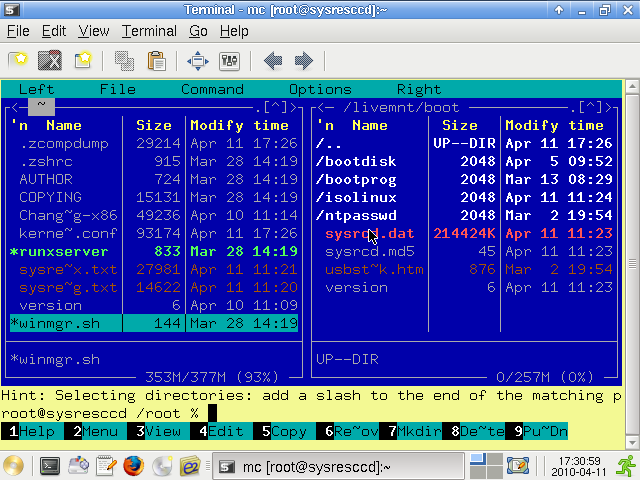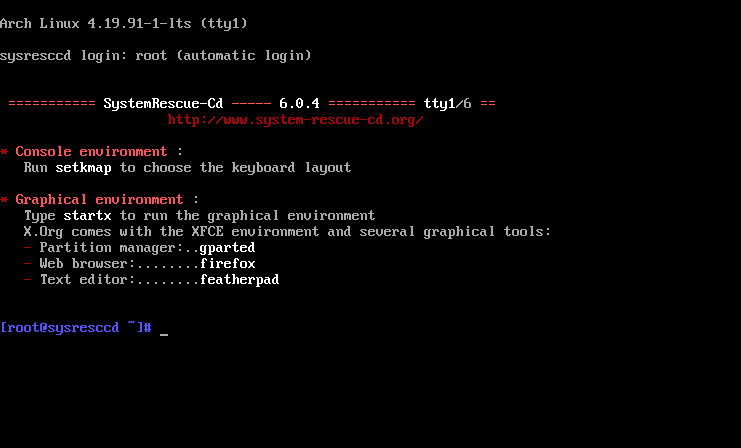

- INSTALL SYSTEMRESCUECD EXT4 INSTALL
- INSTALL SYSTEMRESCUECD EXT4 UPDATE
- INSTALL SYSTEMRESCUECD EXT4 WINDOWS 10
- INSTALL SYSTEMRESCUECD EXT4 PC
- INSTALL SYSTEMRESCUECD EXT4 ISO
While I had been using OpenSUSE for many years, I recently switched to a different Linux distribution called MX-Linux. However, you could easily format the entire hard drive as a single partition for Linux. So I actually have two partitions on that hard drive and the second one is an extra NFTS partition. In the image below, that partition is Disk 2 Partition 1.īecause the Linux partition doesn't need a lot of disk space, I only allocated 250GB of disk space to it.
INSTALL SYSTEMRESCUECD EXT4 PC
As my PC has 3 drives, I actually have Linux installed on single partition of the third disk.

Similar to what you would like to do, I have Windows and Linux installed on two different hard drives. Saw your post and thought I would share my configuration for dual booting Windows and Linux. Jun 16 19:47:27 mint grub-installer: Installing for i386-pc platform. Jun 16 19:47:27 mint grub-installer: info: Running chroot /target grub-install -force "/dev/sda" Jun 16 19:47:27 mint grub-installer: info: grub-install does not support -no-floppy Jun 16 19:47:27 mint grub-installer: info: Installing grub on '/dev/sda' Jun 16 19:47:27 mint grub-installer: dpkg: warning: ignoring request to remove grub-efi-ia32 which isn't installed

Jun 16 19:47:27 mint grub-installer: dpkg: warning: ignoring request to remove grub-efi-ia32-bin which isn't installed Jun 16 19:47:27 mint grub-installer: dpkg: warning: ignoring request to remove grub-efi-amd64-signed which isn't installed Jun 16 19:47:27 mint grub-installer: dpkg: warning: ignoring request to remove grub-efi-amd64 which isn't installed Jun 16 19:47:27 mint grub-installer: dpkg: warning: ignoring request to remove grub-efi-amd64-bin which isn't installed Jun 16 19:47:27 mint grub-installer: dpkg: warning: ignoring request to remove grub-efi which isn't installed Jun 16 19:47:26 mint grub-installer: info: Identified partition label for /dev/sda3: msdos
INSTALL SYSTEMRESCUECD EXT4 ISO
Yes, they ARE actually ISO images that I store there! Recovery is the original Windoze recovery partition, resized to nearly its' got me curious: It makes things much easier to identify during, for example systemrescuecd operations, such a partition resizing. Notice that I take the little time/effort to label my partitions during installation. # swap was on /dev/sda5 during installation # /tmp was on /dev/sda6 during installation # /home was on /dev/sda7 during installation # /Recovery was on /dev/sda12 during installation # /Projects was on /dev/sda10 during installation # /Photos was on /dev/sda9 during installation # /ISOImages was on /dev/sda11 during installation # /Data was on /dev/sda8 during installation
INSTALL SYSTEMRESCUECD EXT4 WINDOWS 10
Sourcing file /etc/default/grub.d/60_mint-theme.cfg' Sourcing file/etc/default/grub.d/init-select.cfg'įound theme: /boot/grub/themes/linuxmint/theme.txtįound linux image: /boot/vmlinuz-5.4.0-84-genericįound initrd image: /boot/initrd.img-5.4.0-84-genericįound linux image: /boot/vmlinuz-5.4.0-81-genericįound initrd image: /boot/initrd.img-5.4.0-81-generic Found Windows 10 on /dev/sda1 Sourcing file /etc/default/grub' Sourcing file/etc/default/grub.d/50_linuxmint.cfg' would have to consider rebuilding a new PC just for fun this is an issue for me right now as its not possible to add a disk.
INSTALL SYSTEMRESCUECD EXT4 INSTALL
I hope you find this information helpful - Let me know if you have any other questions.Īgree that it makes sense to install in separate disk. I hope you find this information helpful - Let me know if you have any other said:

I honestly recommend instead using two separate disks to run Linux & Windows, and perhaps putting the shared data on a partition on one of the disks instead, as it will require less effort on your part, or consider running Windows or Pop! OS (or another distro of choice) on a virtual machine.
INSTALL SYSTEMRESCUECD EXT4 UPDATE
Windows 10 is known to be very intrusive upon the boot loader for system disks, and dual booting Windows 10 with Linux has become more difficult as a result, so after a Windows update or at random when it thinks there is a disk problem (because it sees the bootloader has been tampered with outside Windows, or has seen your Linux partitions and thinks they are corrupt parts of the disk), you may find Linux won't boot anymore. This article as well may also be helpful: This tutorial may be helpful, though it assumes you are starting from a blank system disk to partition and install both Pop! OS and Windows to, with Pop! OS being installed first and having some certain settings adjusted during the installation: Pop! OS tries to implement Grubless UEFI booting which may not play nicely with Windows 10.


 0 kommentar(er)
0 kommentar(er)
